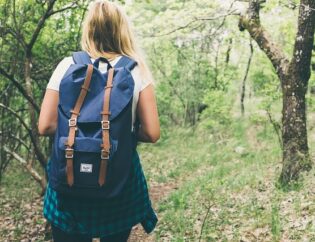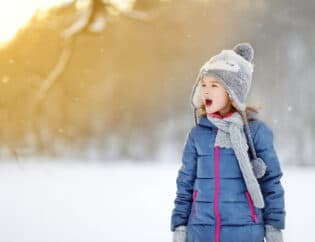
If yours is an outdoor family, you know that when the temperature drops, the fun really starts. Winter is the serious nature lover's season for getting outside. It offers so many ideas for things to do outdoors with kids.
And we’re not just talking about sleighing, skiing, or ice skating. To make sure your family gets the most out of the energizing cold season, we've put together this list of our favorite family winter activities that we hope will help keep your family outdoors and active this season.
Tune in to the silence of winter. There's nothing quite like a peaceful walk in nature right after a fresh snowfall. Blissful. Silent. Mesmerizing. But listen closely and hear how the wind howls. The snow crunches. Winter is a wonderful time to help your child tune out distractions and tune into the sounds of nature. Try our quick, 15-minute “sounds of nature” activity, which hopefully will help your child discover a whole new world, be more mindful and more tuned in to nature, and understand the importance of nature
Go tracking. What a perfect season to practice animal tracking. Animals often gather and feed on winter foliage. Tracking animals is easier in the snow and is an excellent way for your child to learn about wildlife and ecology as the art of tracking consists of answering such questions as: Why would an animal be in any given area? When did an animal leave its sign? Where did the animal go? Where did it come from?

Find winter birds. Snowy owls. Harlequin Ducks. Northern Shrikes. These are among the birds you might spot if you head out birding with your kid in the winter. Of course, the species will depend on where you live but you’re always in for a treat when you go birding in our opinion. It’s incredibly rewarding and fascinating. And...it gets kids outdoors! Once kids start birding, they’ll never see the outdoors the same way again. Winter bird-watching is cold but exciting. It’s actually easier to spot birds when not much else is buzzing or flying overhead.
 Head out on a scavenger hunt. Chickadees feeding. Starlings flying. Snow melting. Icicles forming. There is so much to see in winter if you want to look! A super fun way to get your kids looking is with a winter scavenger hunt. Setting your kids off on a scavenger hunt in nature can really make the outdoors come alive for them. Being on the “hunt” for signs of nature will help develop your child’s nature observation skills and deepen their connection to and comfort level with the outdoors. And of course take along our free, downloadable winter scavenger hunt printable. This activity brings in the benefits of playing outside
Head out on a scavenger hunt. Chickadees feeding. Starlings flying. Snow melting. Icicles forming. There is so much to see in winter if you want to look! A super fun way to get your kids looking is with a winter scavenger hunt. Setting your kids off on a scavenger hunt in nature can really make the outdoors come alive for them. Being on the “hunt” for signs of nature will help develop your child’s nature observation skills and deepen their connection to and comfort level with the outdoors. And of course take along our free, downloadable winter scavenger hunt printable. This activity brings in the benefits of playing outside
Create winter homes for garden wildlife. What we see it as a forgotten corner of the yard, many species see as high-end real estate. That undisturbed corner of your garden is needed by wildlife in need of a winter home. Your wintering site can take the form of a pile of logs that mice, wren or foxes will use to a pile of rocks and stones that amphibians or worms can take cover under. Never remove piles of leaves from your yard. Small animals love leafy and woody piles as an ideal place to spend the winter. Also, a compost heap is an additional winter habitat for wildlife.
Make it Cozy. If your family prefers to stay warm and cozy seeking that wonderful feeling the Danes call hygge, the outdoors is for you too! Just bring out some warm blankets and set up around your outdoor campfire for a warm and cozy outdoor meal. If you don't have your own outdoor fire pit, have a look at this campfire cooking collection kit we love from Wolf and Grizzly.
Go stargazing. Stargazing in the winter is a great way for your child to learn new constellations as well as experience the calm of being outside at night. There are a whole host of constellations that are best observed in the winter months. And of course, it’s a wonderful chance to watch your kids delight at the world around them.

Make some ephemeral winter art. Ephemeral art is a work of art that only lasts for a short amount of time, perhaps occurs once, and cannot be embodied in any lasting object. A perfect medium for ephemeral art, of course, is snow or ice. Rather than make a standard snow fort (though you can never build enough snow forts in our book), go for an ephemeral work of art together. Get inspired by ephemeral art master, Andy Goldsworthy with these pieces in which the artist meticulously creates winter sculptures from ice, frost, snow, and frozen earth. Prepare to be stunned.
Celebrate the winter solstice with a winter feast for wildlife. Teach your child about the needs of wild birds and optimize your backyard birdwatching experience by attracting resident species and migrating birds with a backyard buffet of nutritional food for birds. Whether you make your own feeder or buy one ready-made, winter is a great time to reward feathered critters with a feast!
Get active. Winter does not mean all activities must come to a crashing halt. Quite the contrary. Winter is an excellent time to be active outdoors. Running, hiking, skating, snowshoeing, sledding and skiing are all excellent activities that either can only be done in winter or are just a little more challenging. The key to keeping kids happy and safe during winter outdoor time? Dress them for the occasion in warm gear. Pay particular attention to warm, water-resistant footwear as dry, warm feet equal happy kids! And don't forget to let your kids express their own style too! We love these headgear options from Turtlefur.
Capture this fleeting season. Get a waterproof field notebook and do a sketch of a winter landscape. This is an excellent season to start a winter wildlife journal or make a scrapbook of winter sketches. With less to focus on, your child can direct their attention to really focusing in on the details.
Practice being a naturalist. Encourage your child to start a winter field note journal so they can notice changes during winter from previous seasons. A good idea is to return to a natural area they spent some time in during warmer months, such as a nearby pond. During the spring and summer, ponds are teeming with wildlife and sights and sounds of nature. Though many critters like insects and amphibians will be safely spending their winter in the warmth under the pond floor, depending on where you live, ducks and geese may be around, as might some birds such as starlings or sparrows. If your child needs more direction, have them choose a citizen science project that gets them outdoors in the winter. Sometimes having a specific goal motivates a child pretty easily!
Build a snow fort. We love forts! And so do kids! Stick fort or snow fort, any type of fort is a fun way to spend outdoor time. In the winter, your child might want to take on a snow fort-building project. Suggest that they make some snow blocks using empty milk cartons and then wet the blocks down. Let them freeze overnight then pile them up for their own igloo.
Write a nature poem. Winter landscapes present endless sources of beauty and inspiration—perfect for some nature poetry. If your child balks at the idea of writing a poem about winter, remind them that about half of the world's population has never seen snow close up!
Play tree detective. Encourage your child to notice a naked tree. Normally, the shapes of the deciduous trees are hidden by their leaves. In the winter, their shape is much easier to see. Sketch the trees and try to relate it to common shapes. Even without leaves, flowers, and fruit to help you, winter's a great time to identify trees. The tree’s bark, buds and twigs, and the sad remaining leaves provide great clues. We love this resource to help ID winter trees!

Become a tree friend. Though any season is a good time to adopt a tree, winter is a time when a tree bares its soul. Encourage your child to befriending a nearby tree. Being a tree friend is a great way for your child to learn about one of the most important living things on this planet— and one that is likely just outside their door. Your child can learn about the vital role of trees, develop an appreciation for these dependable but dynamic organisms and have a great reason to head outdoors regularly. Using our free, downloadable tree journal will help them notice the shape of the tree as well as its community, or who is living in it!
Go nest spotting. With the absence of leaves on deciduous trees, nests are much easier to spot in the winter. Since they are uninhabited at this time, it is a great opportunity to take a closer look at the shape and form of nests constructed by different animals. What types of materials do you see in the nests? What type of bird or animal do you think lives in that nest? The Northern Woodlands website has an excellent resource for identifying birds by the nests they build.
Sketch a nest. We love the nest sketches created by Bernd Heinrich, a professor emeritus of biology at the University of Vermont and author of the book, Nesting Season. Ask your child to use them as a model as they sketch out the varied forms a bird's nest can take.

Study a snowflake. They’re magical, beautiful shapes that fall from the air landing softly. Though no two snowflakes are alike, they are always hexagonal. Take a closer look at these mini airborne physics lessons in disguise with your child as you do a snowflake study together. Just put out a dark towel when the snowflakes start and bring out your magnifying glass to get a closer look.
Practice friluftsliv. You've probably seen a few books about this sensation last year on bookshelves everywhere. All of the world fell in love with the Norwegian concept which translates roughly to “open-air living” or a commitment to celebrating time outdoors, no matter the weather. Need ideas for bringing friluftsliv into your family life? Norwegian Alexander Read writes about his father-daughter friluftsliv journeys with his toddler on Instagram. But don't be intimidated, friluftsliv doesn’t have to mean trekking to the top of the mountain in winter. It can also be about long walks with your family in nature, outdoor picnics, or snowshoeing on a Sunday morning.
A few of the links in this post are affiliate links. This means if you click on the link and purchase the item, we will receive a small affiliate commission at no extra cost to you. All opinions remain our own.











